
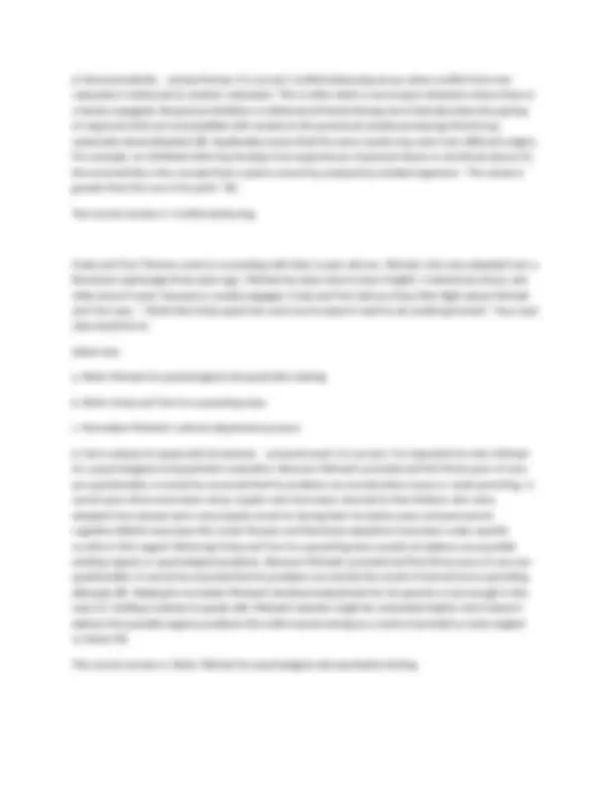
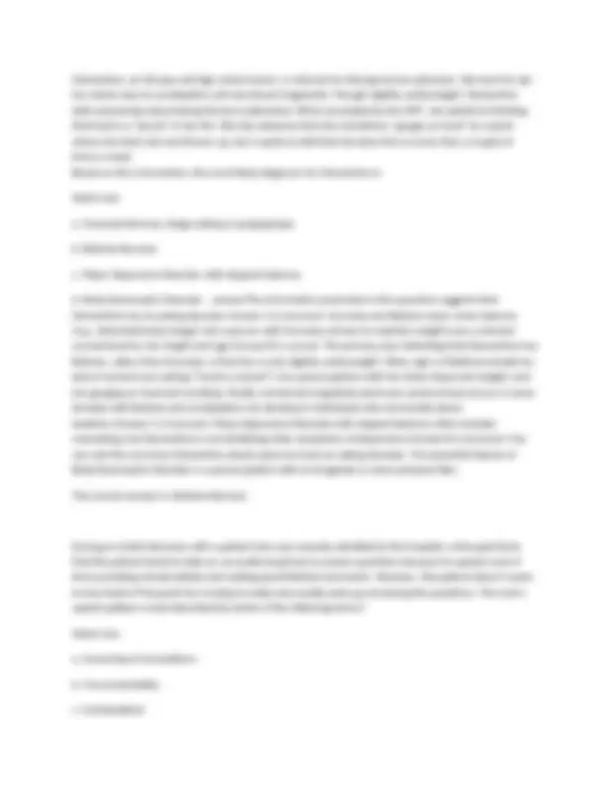
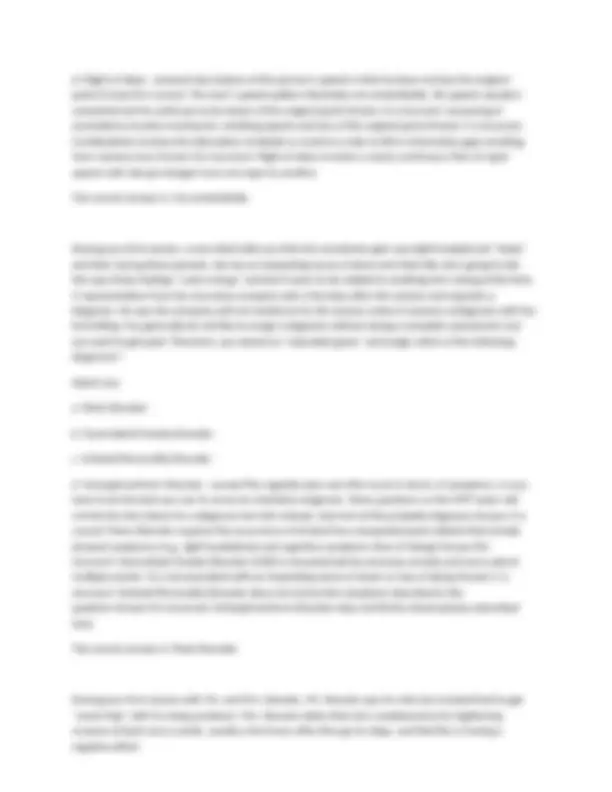

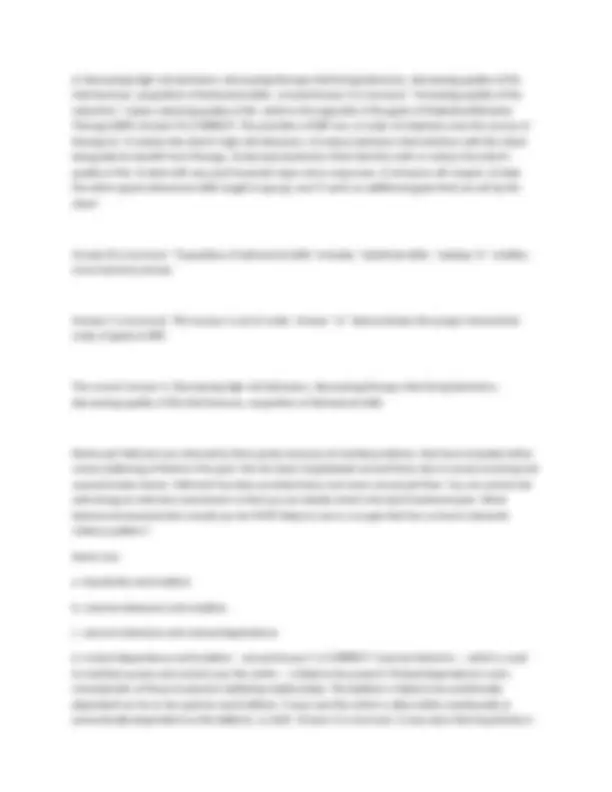
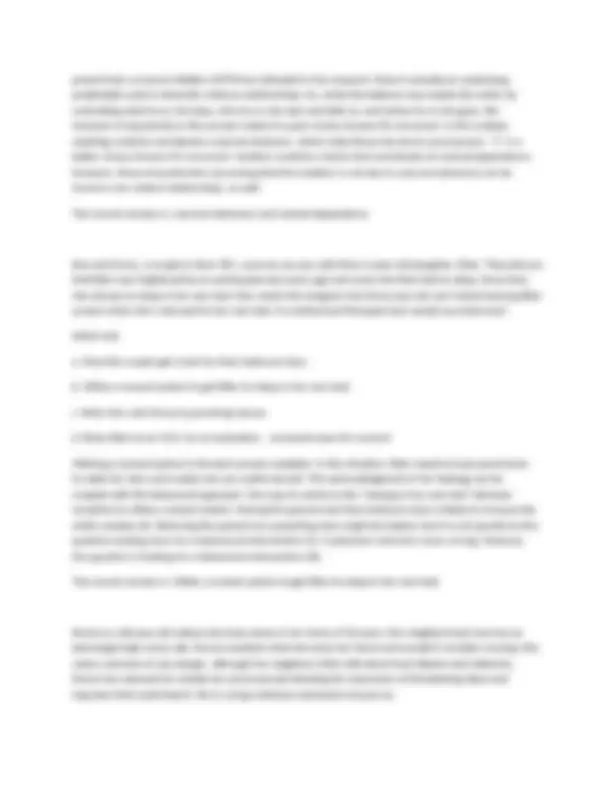
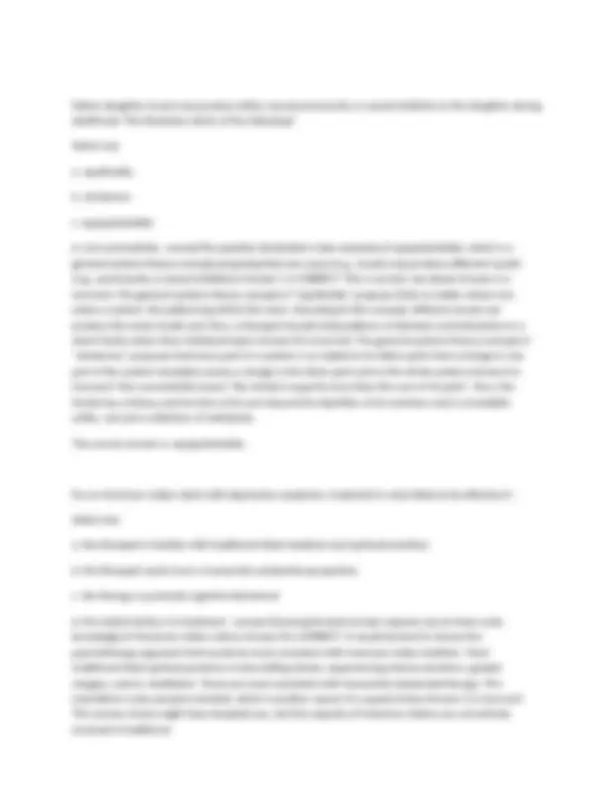
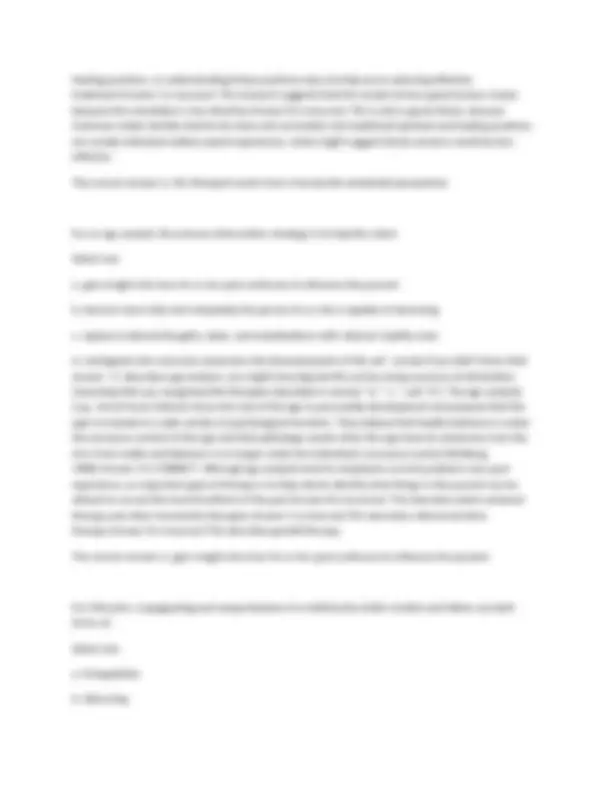
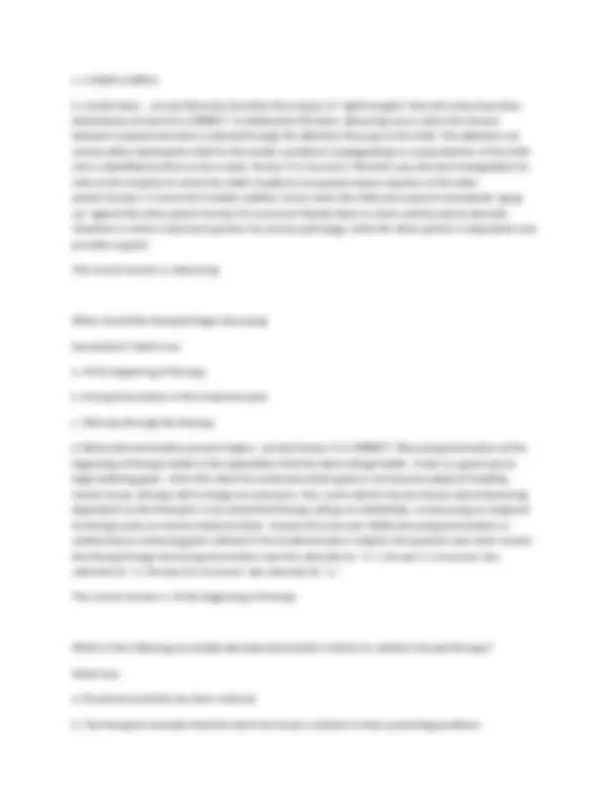
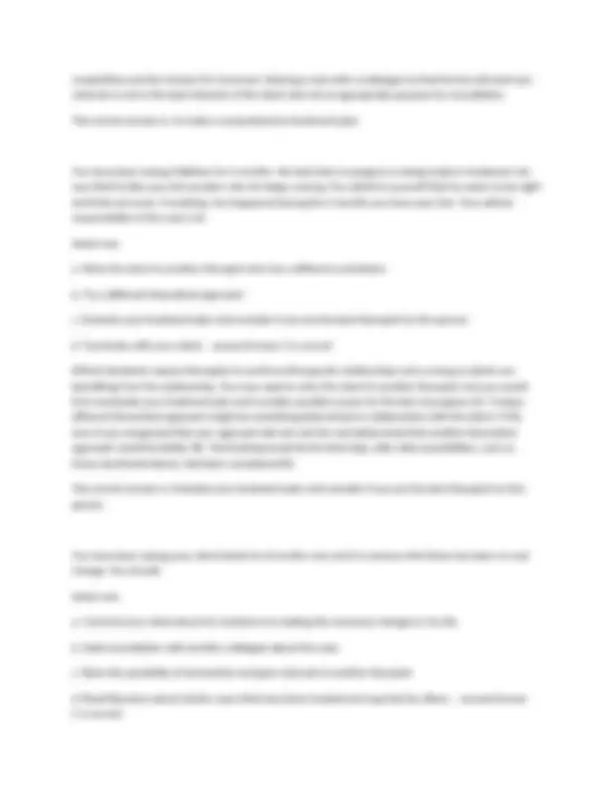
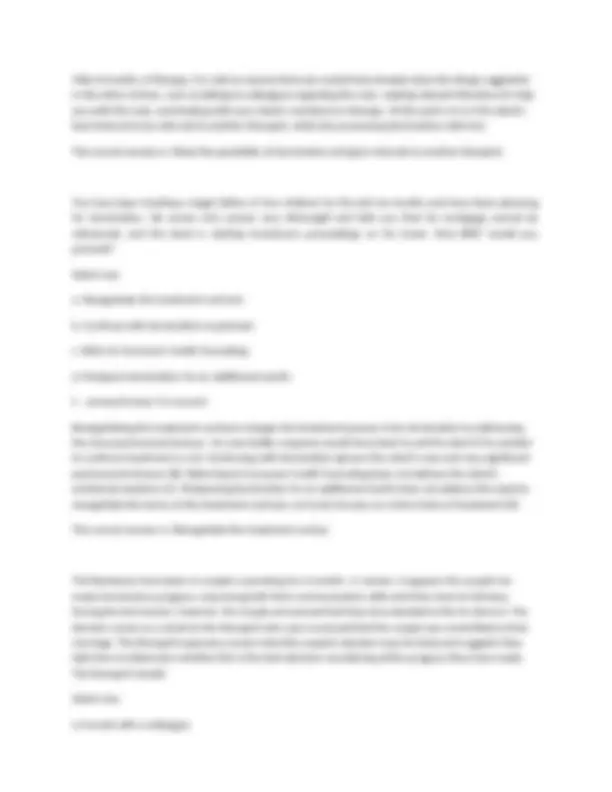

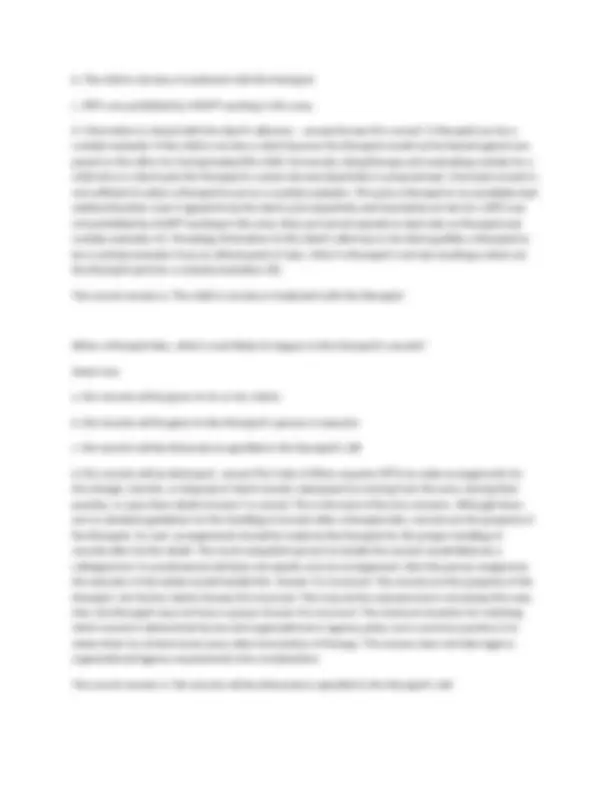
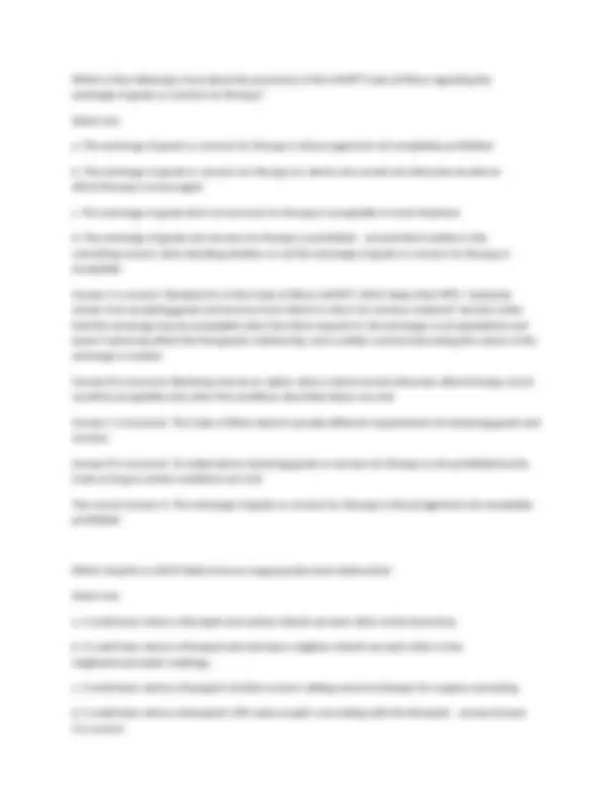
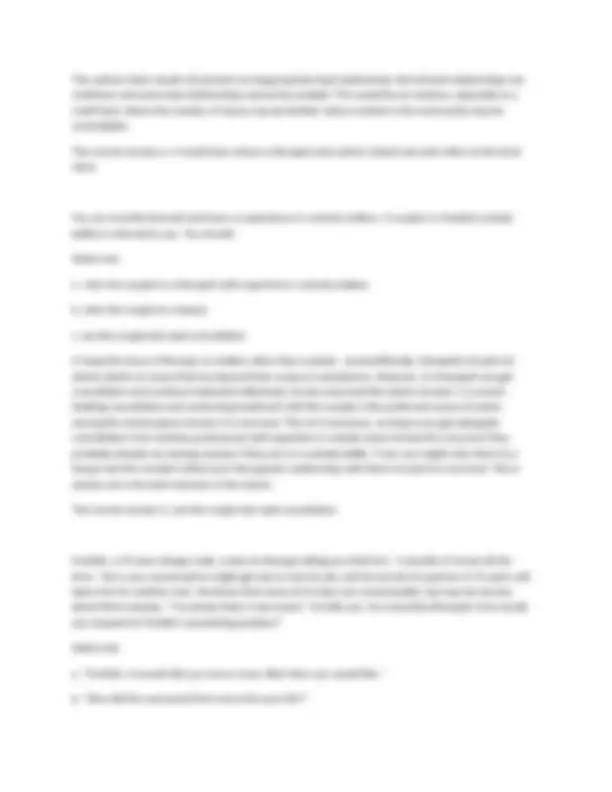
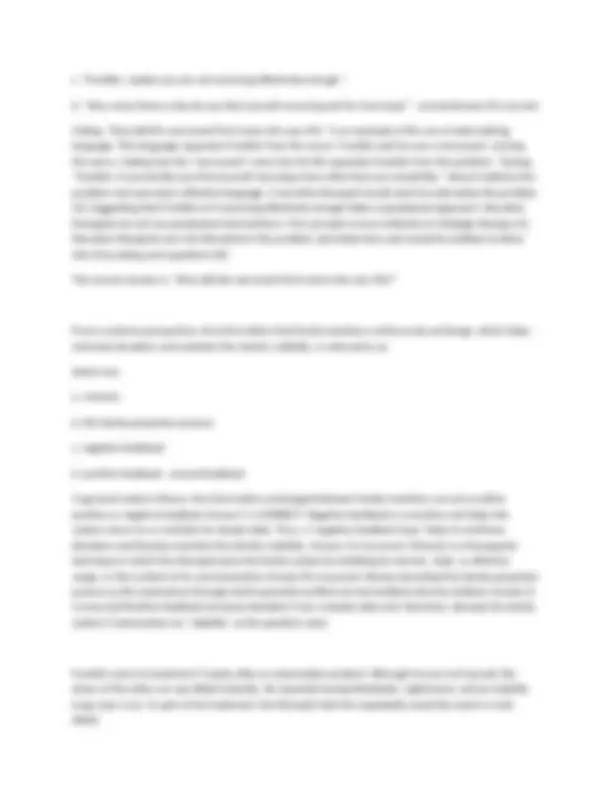
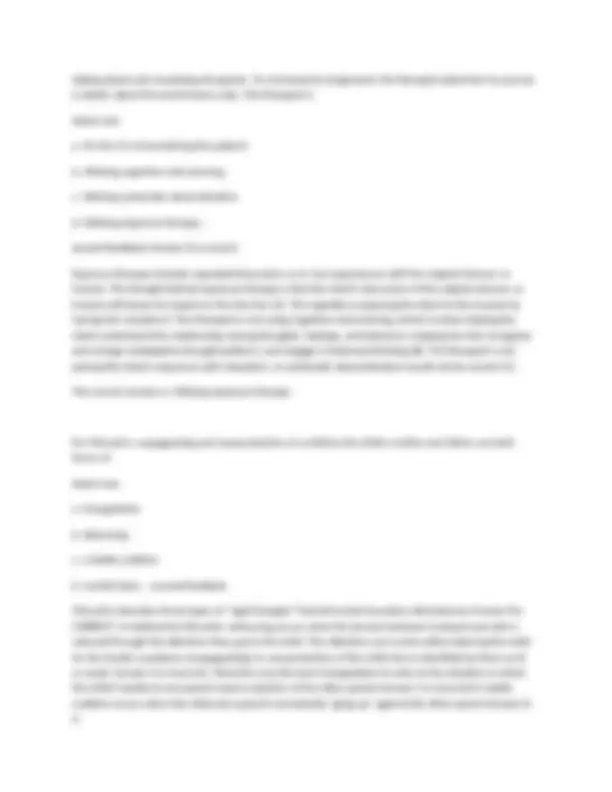
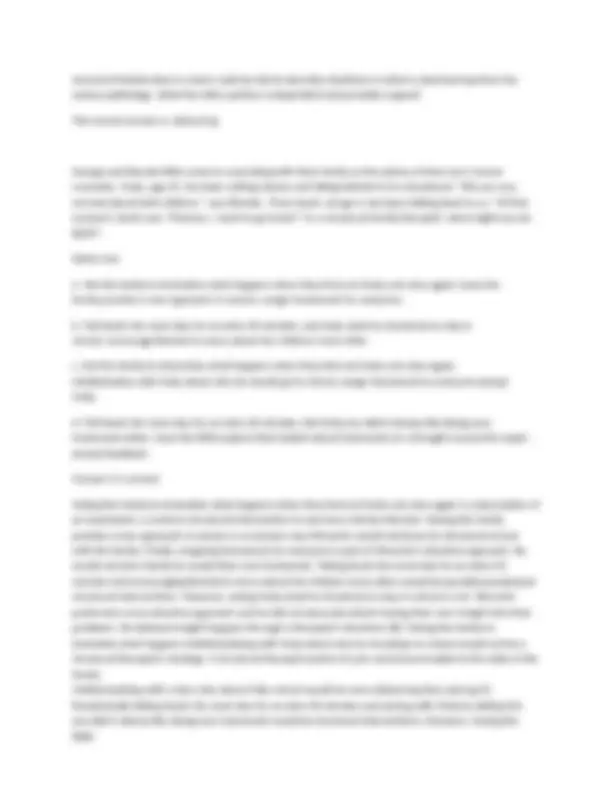
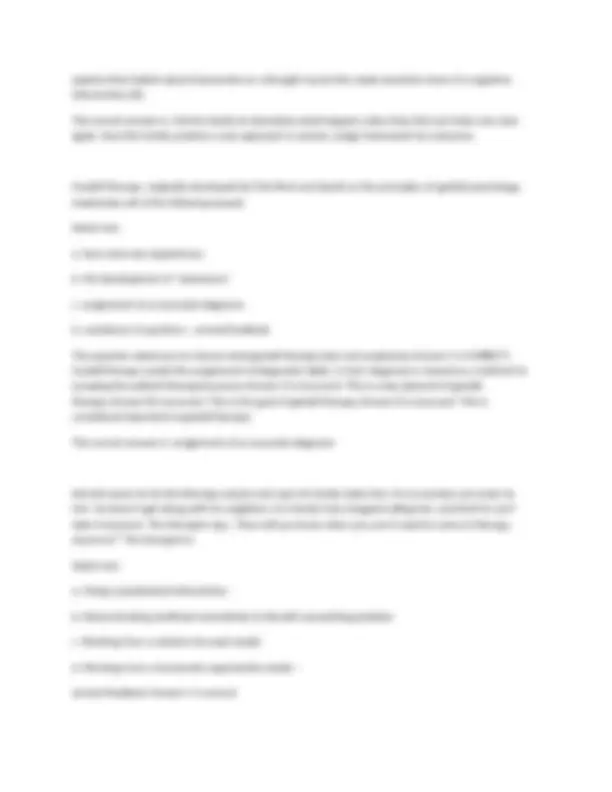
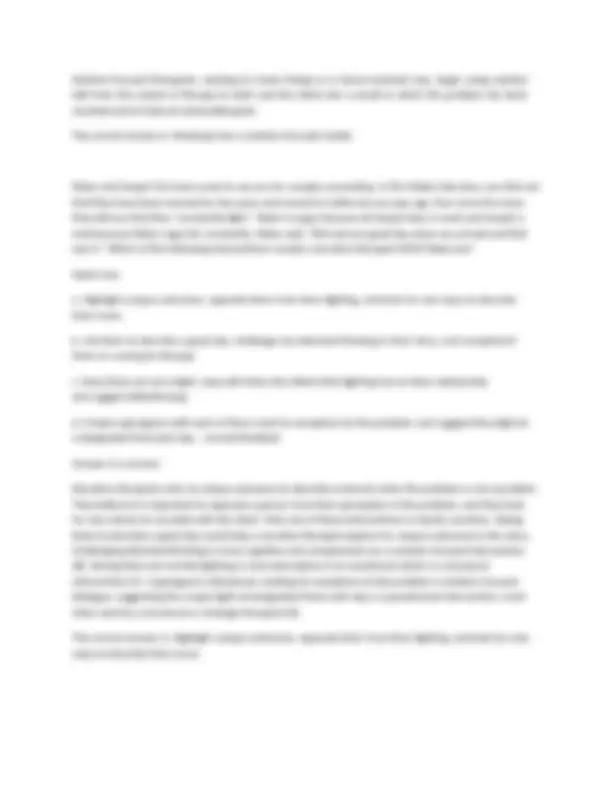
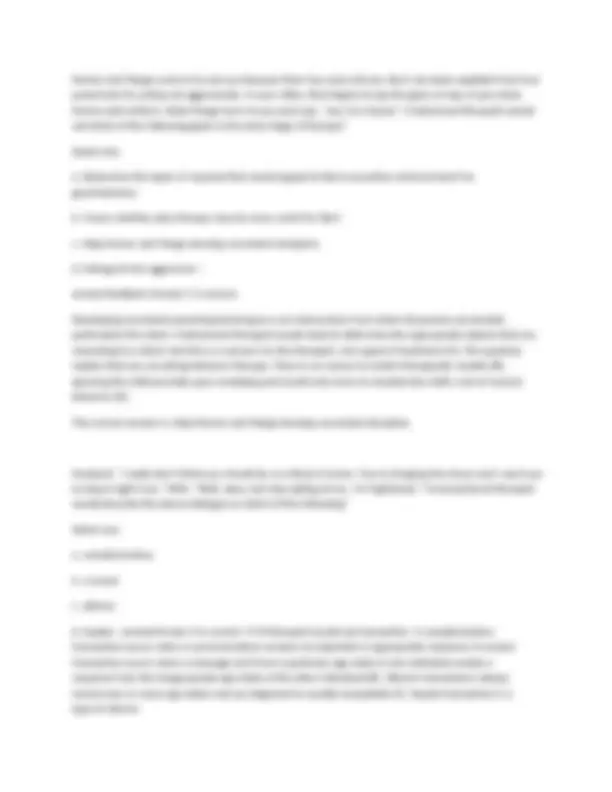
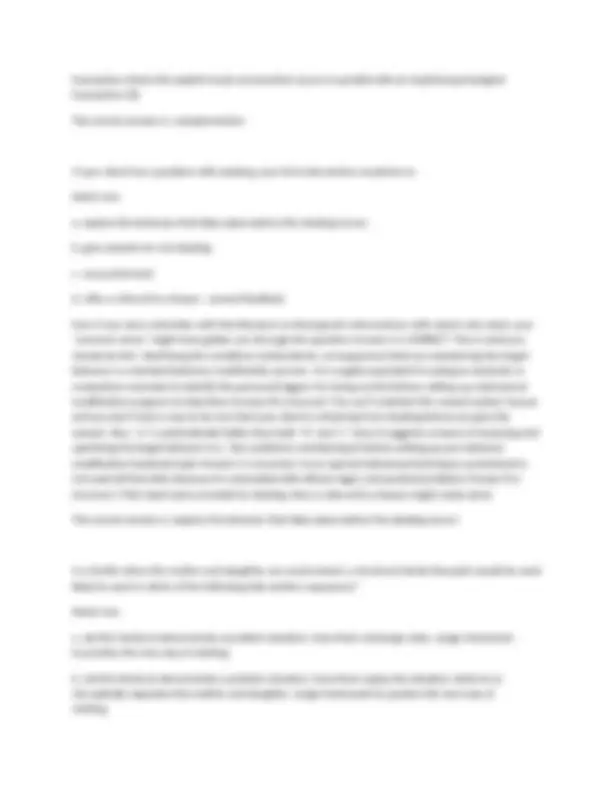
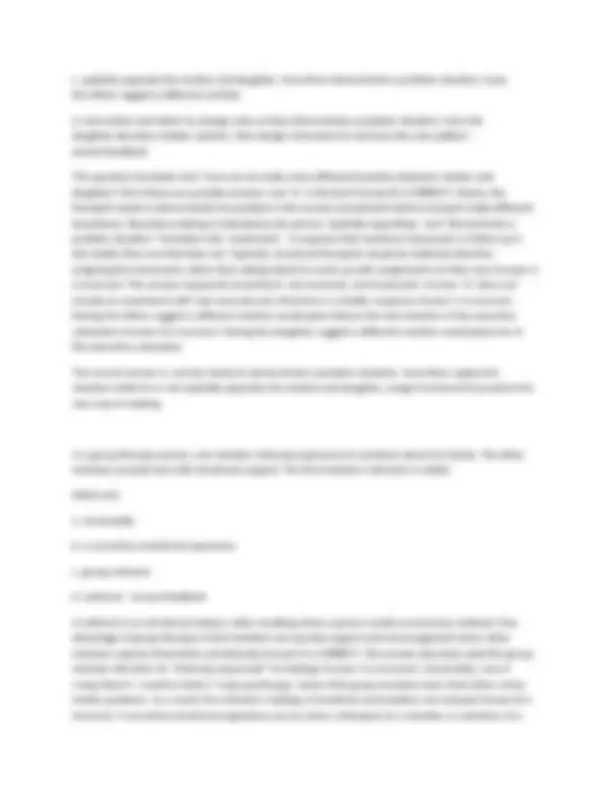
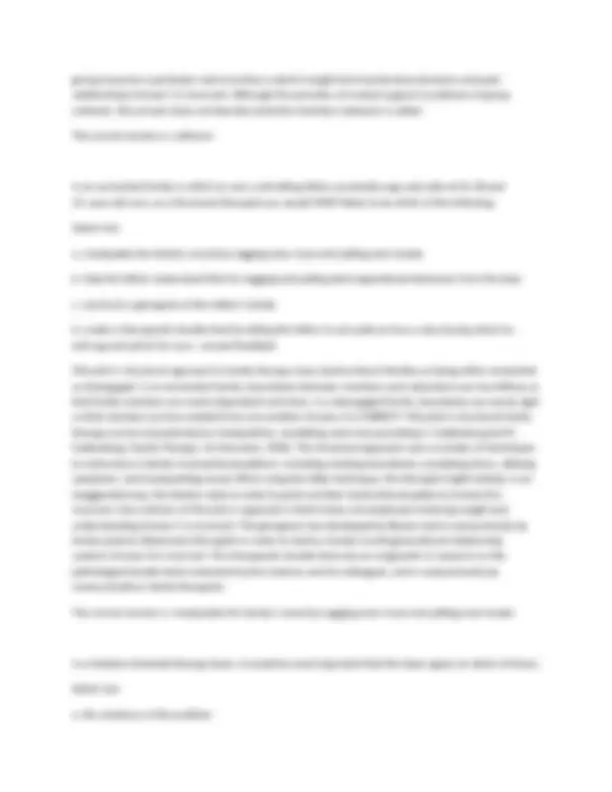
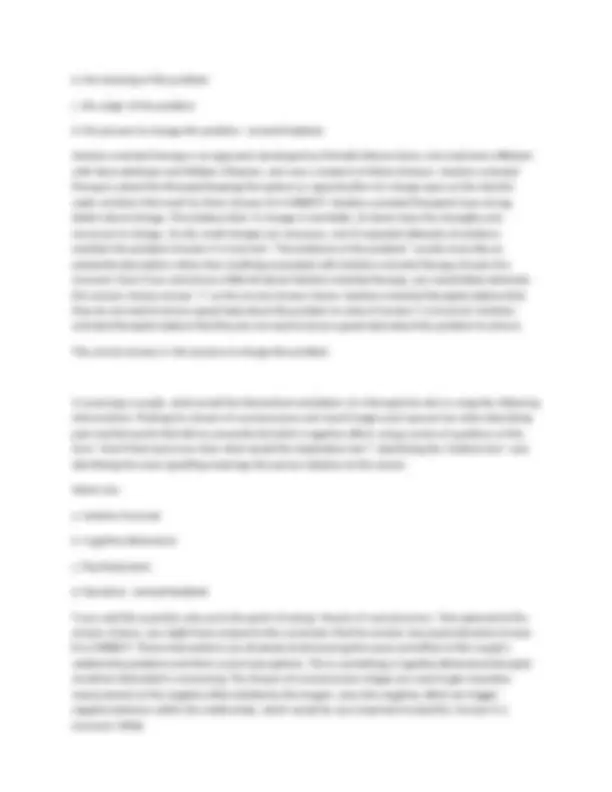
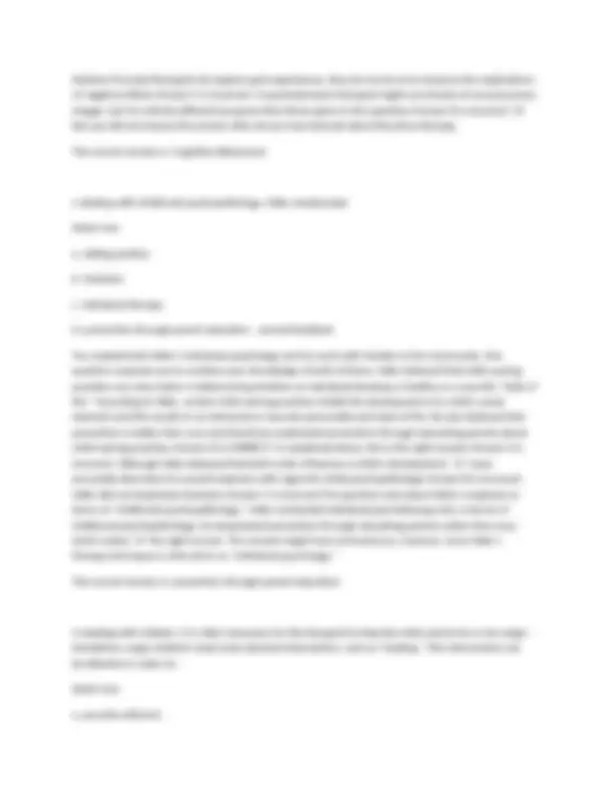
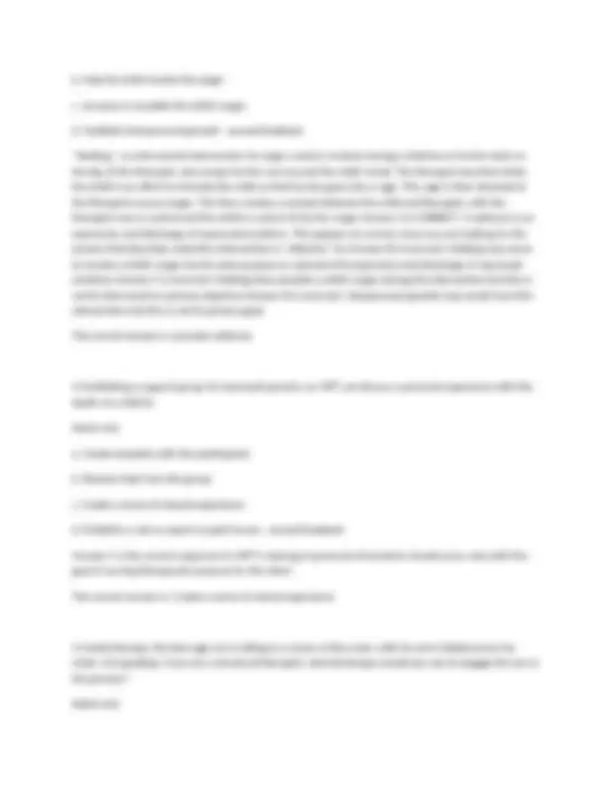
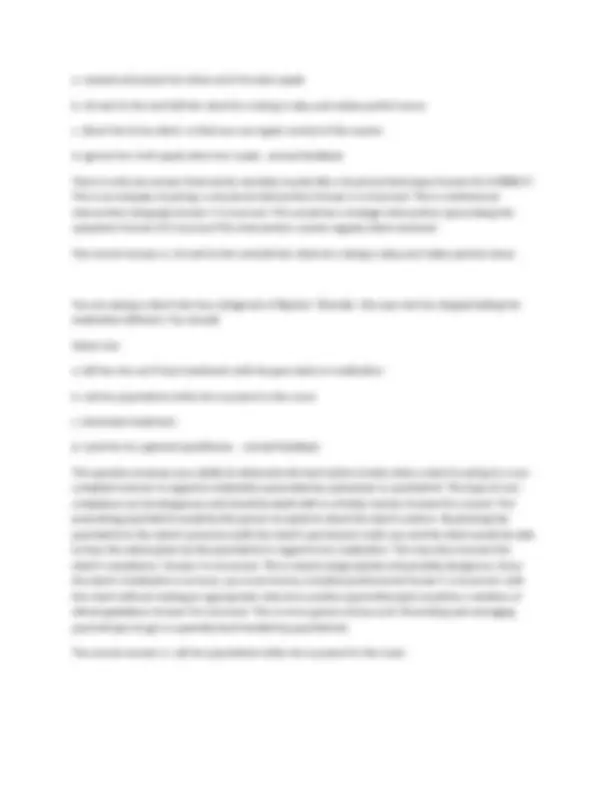
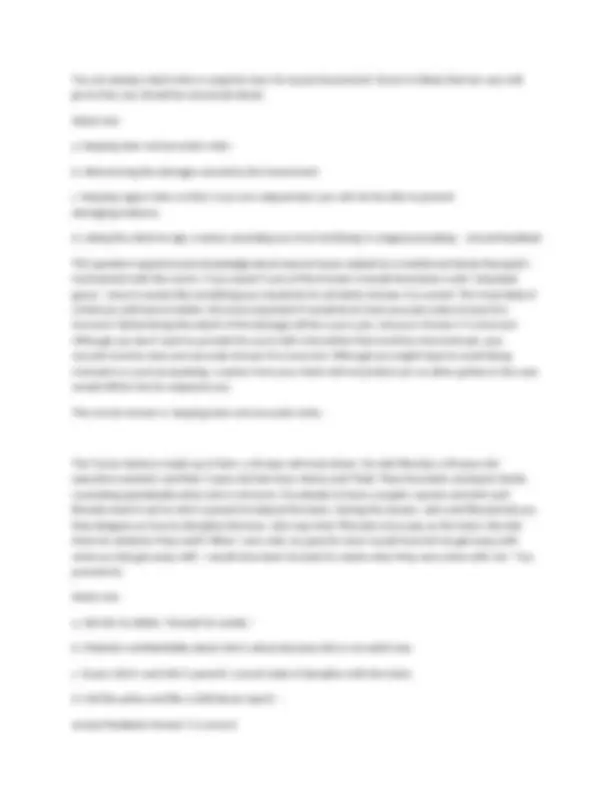
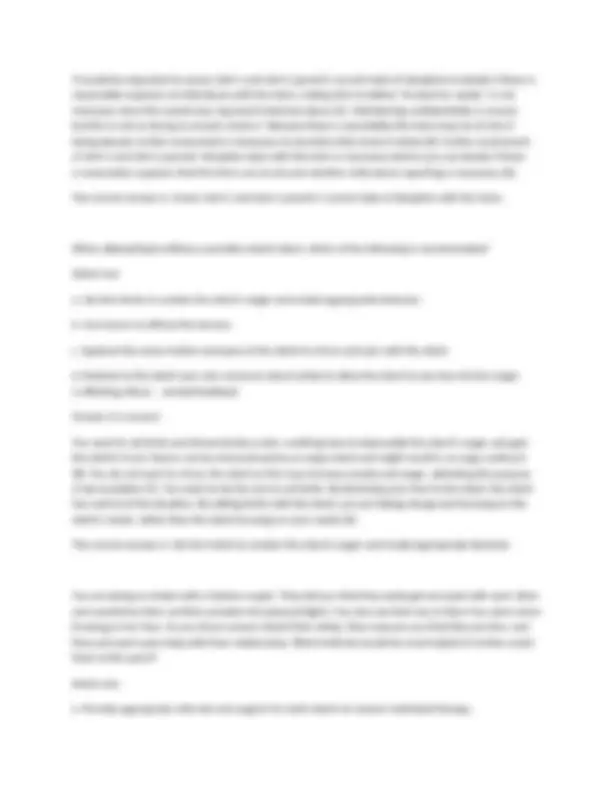
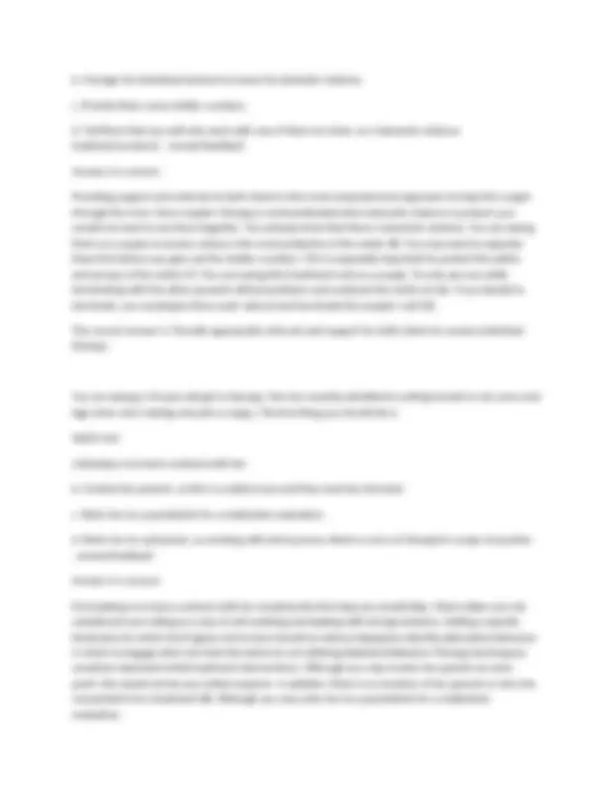
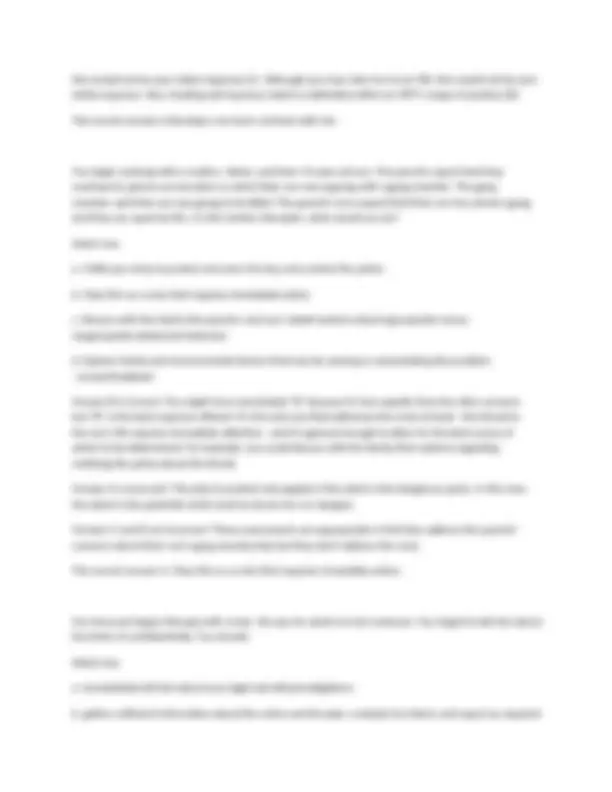
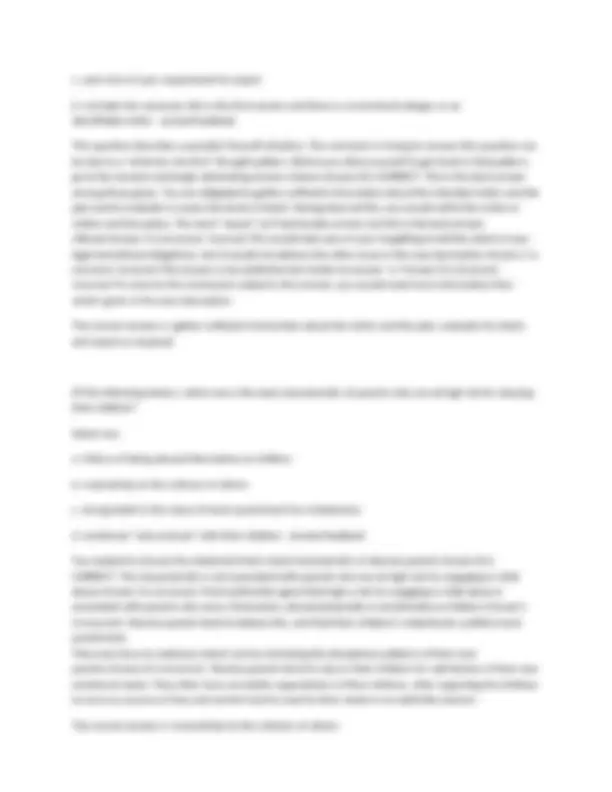
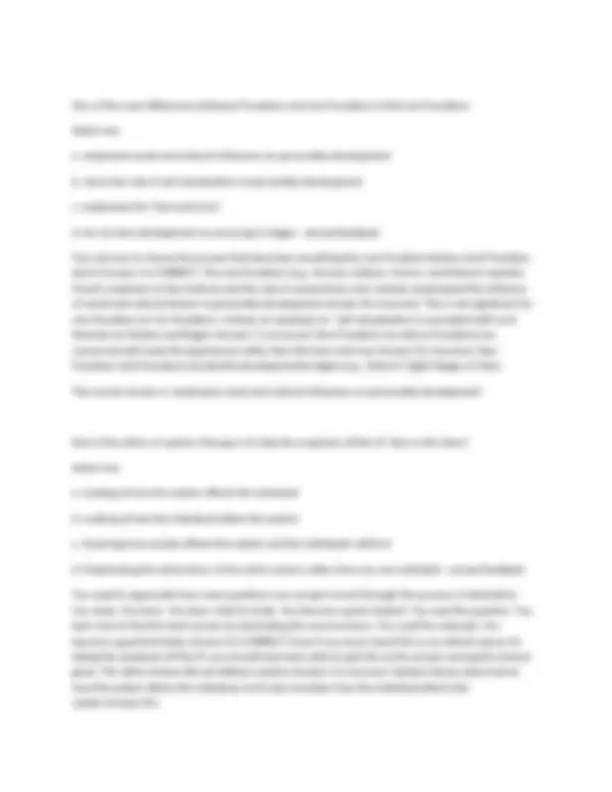
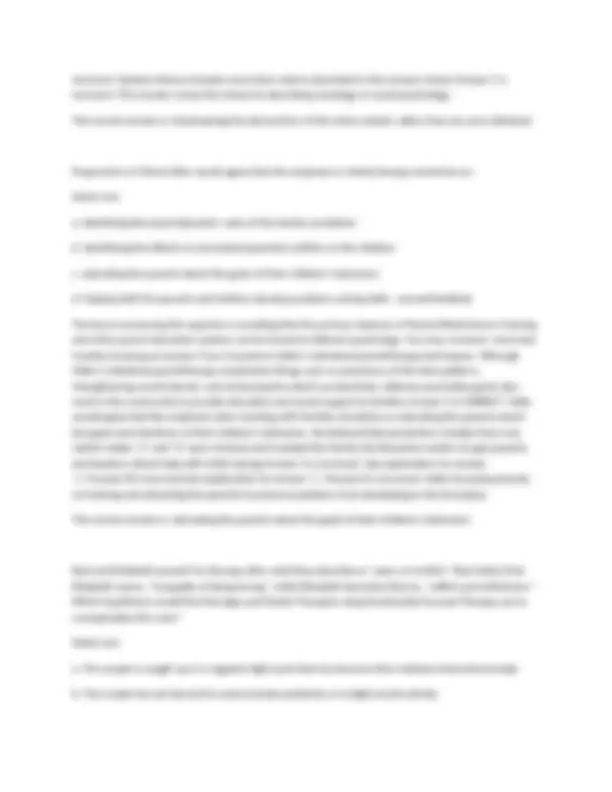
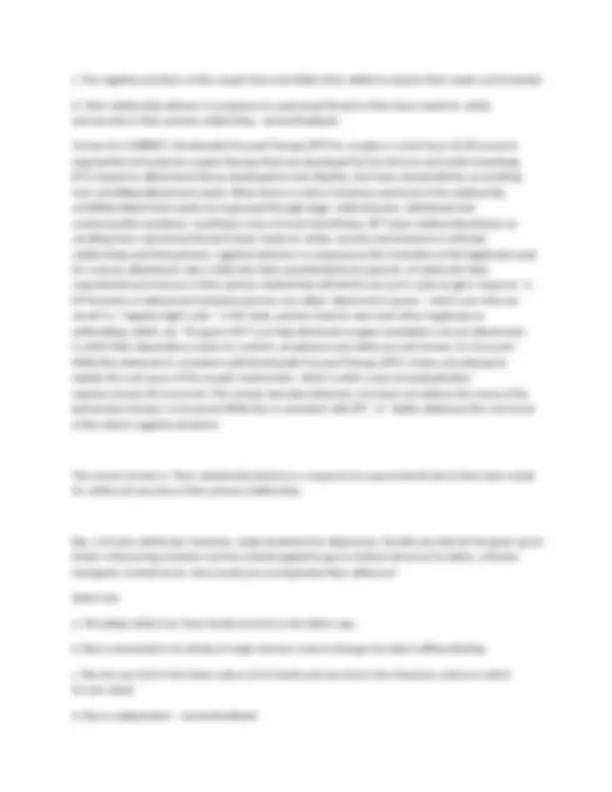
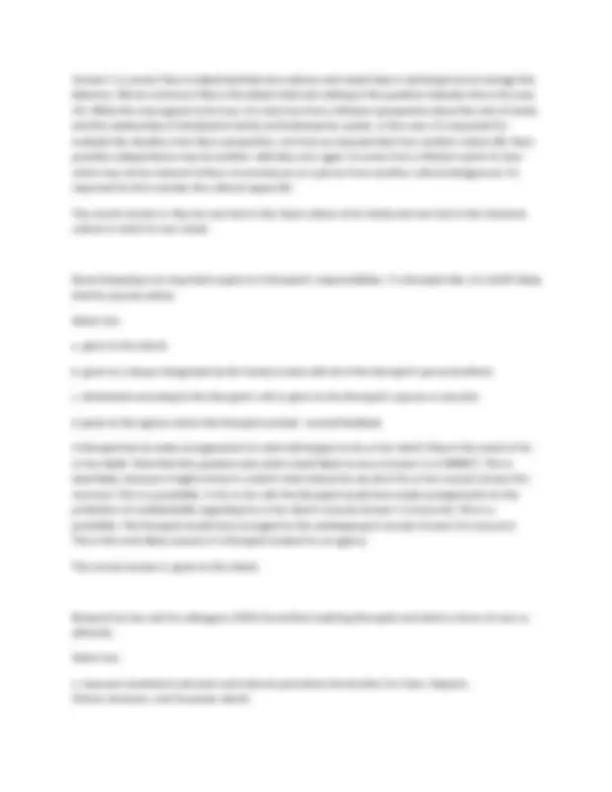
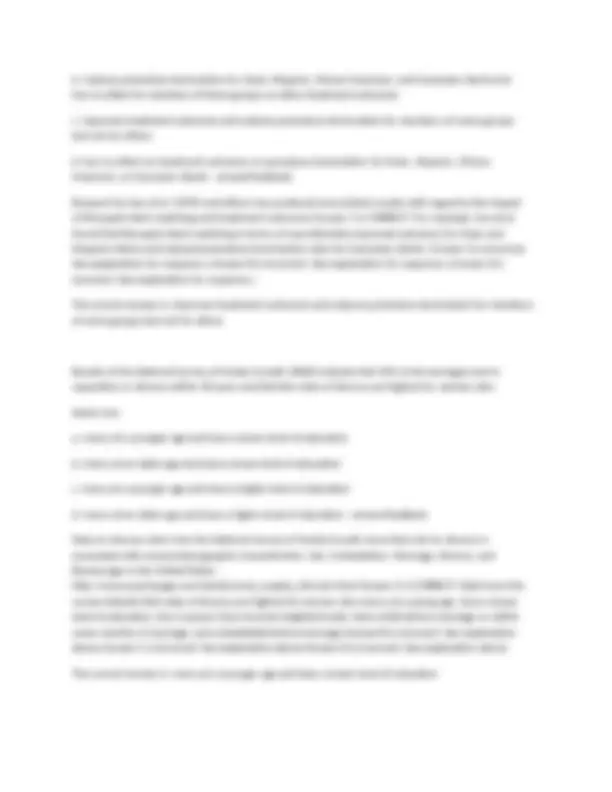
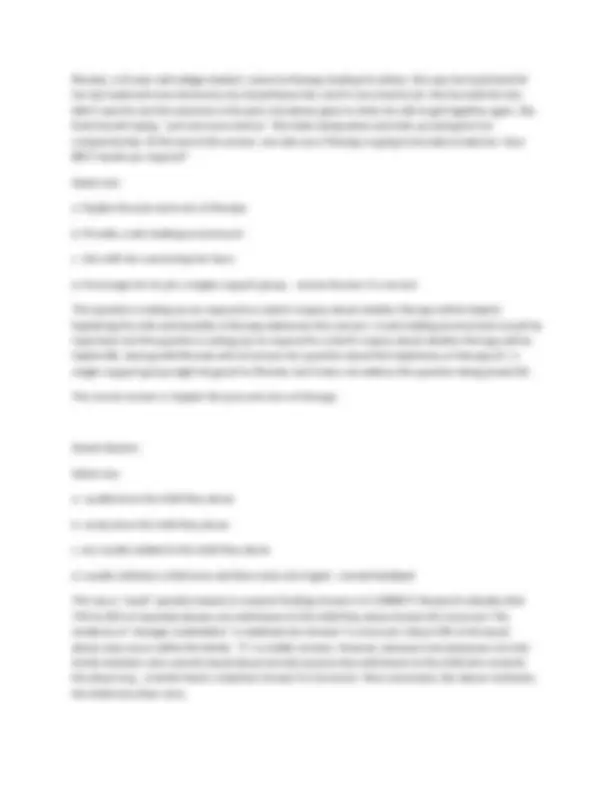
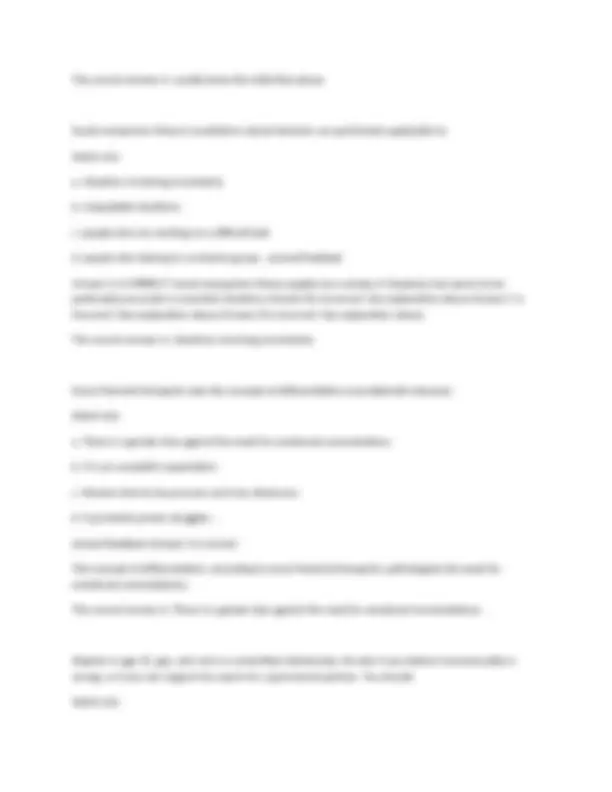
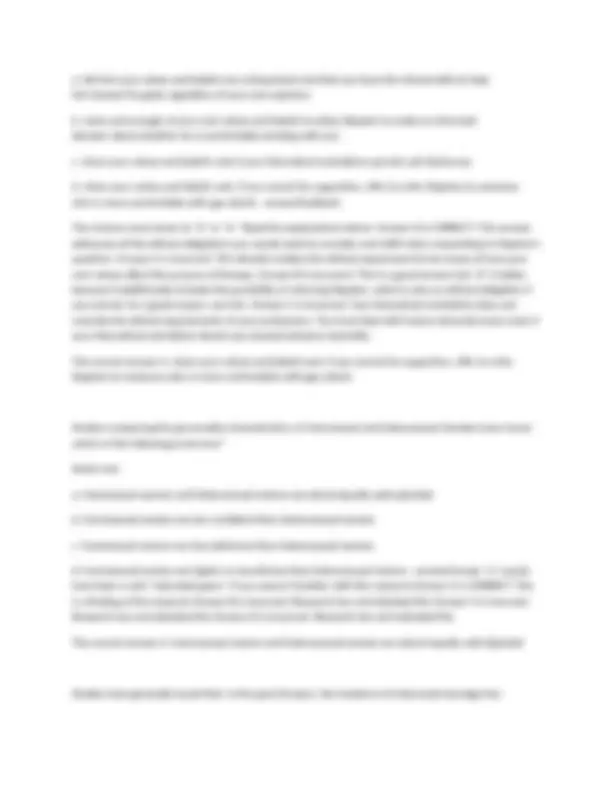
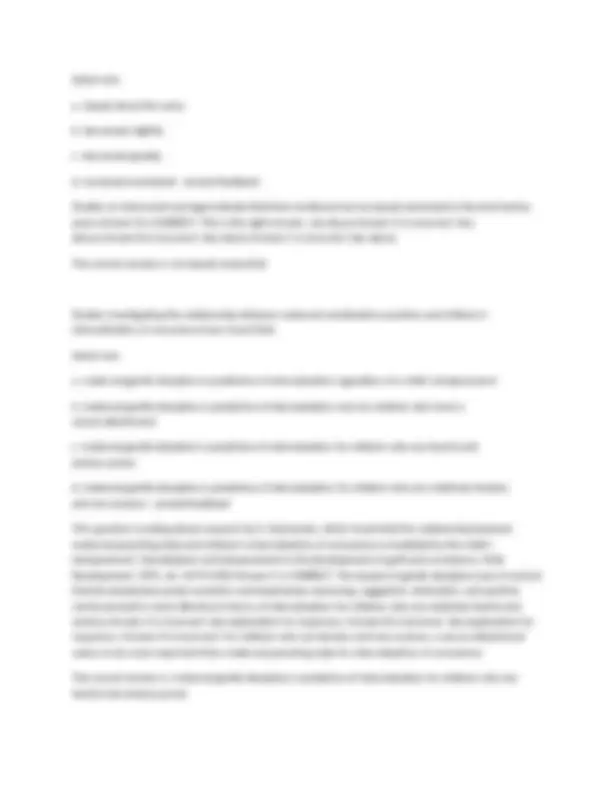
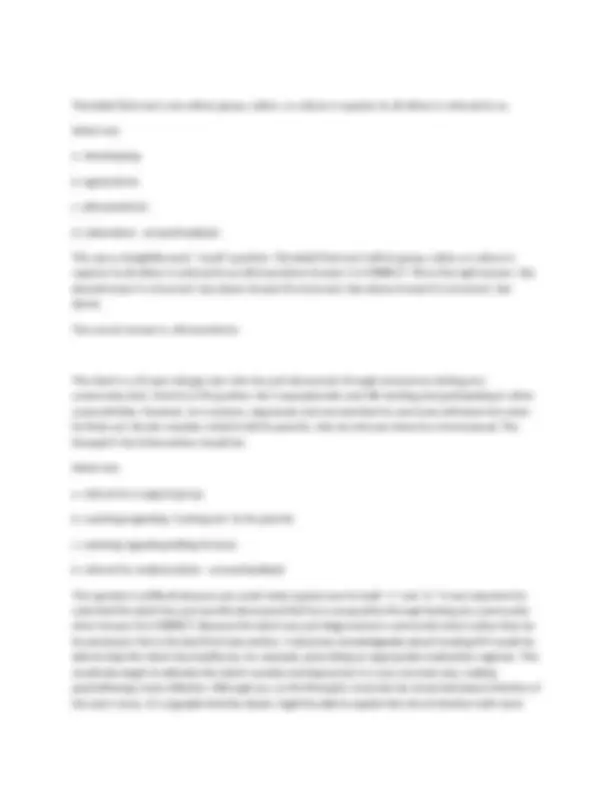
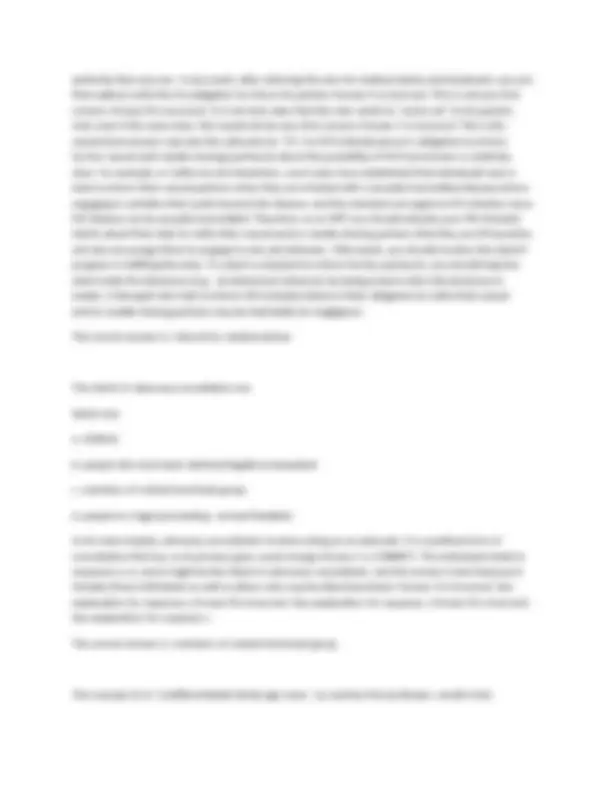
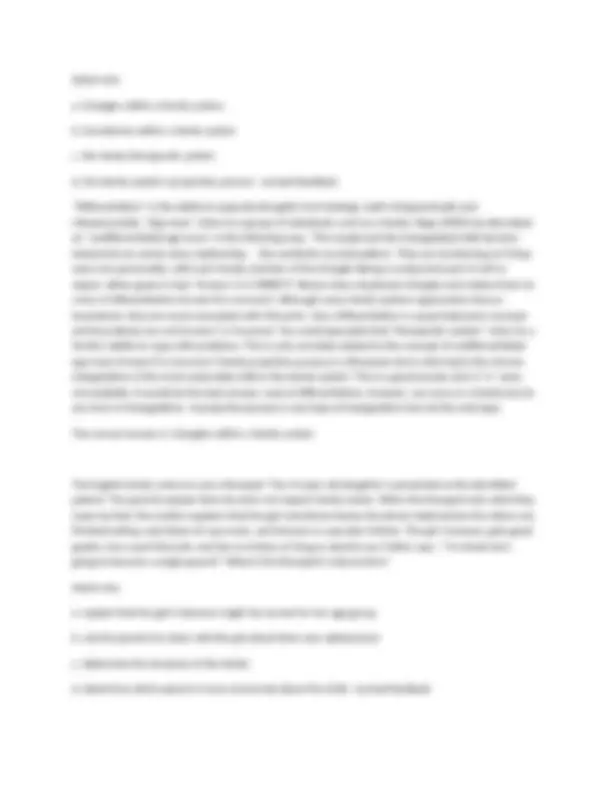
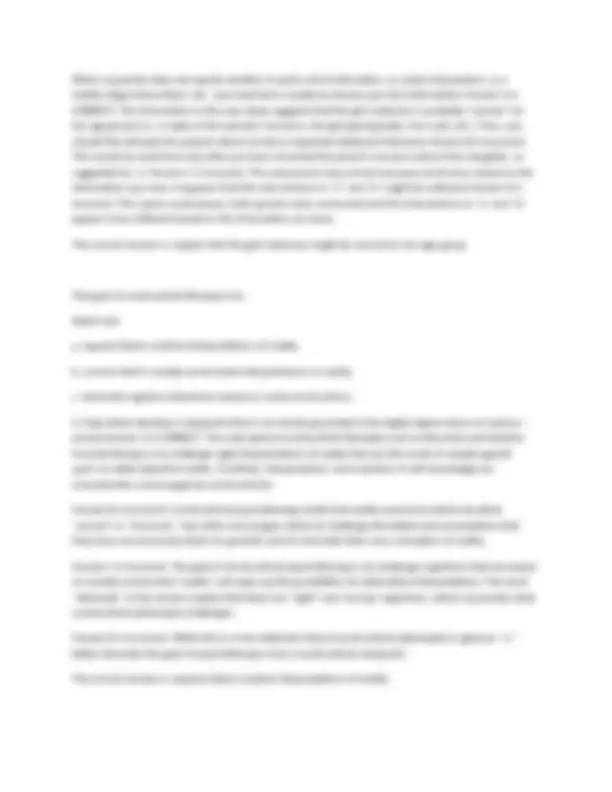
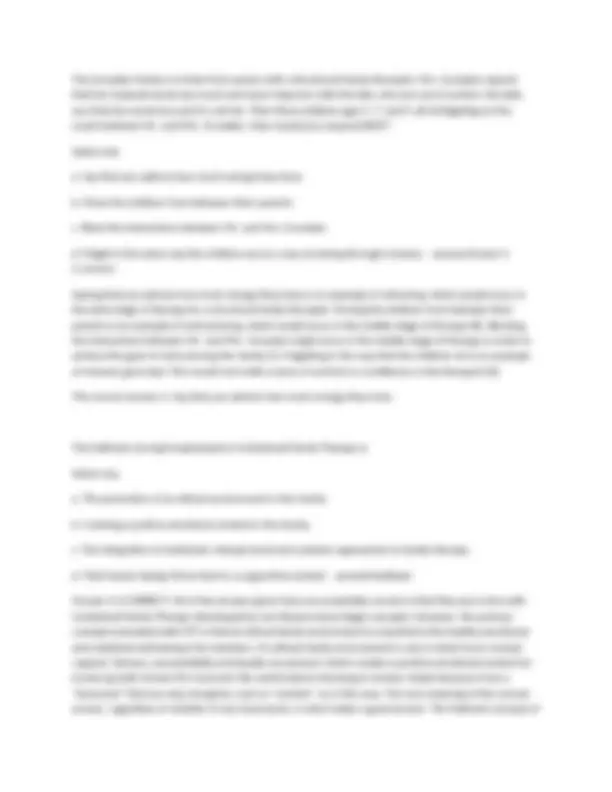
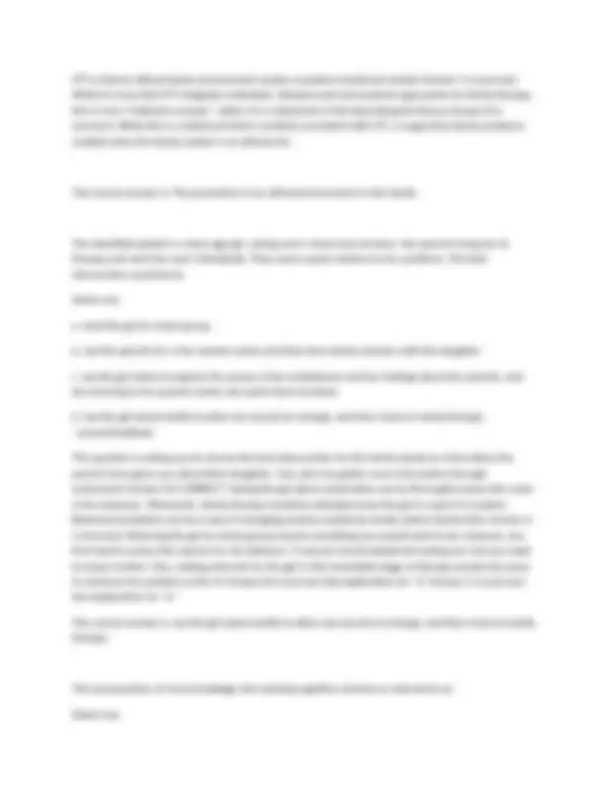
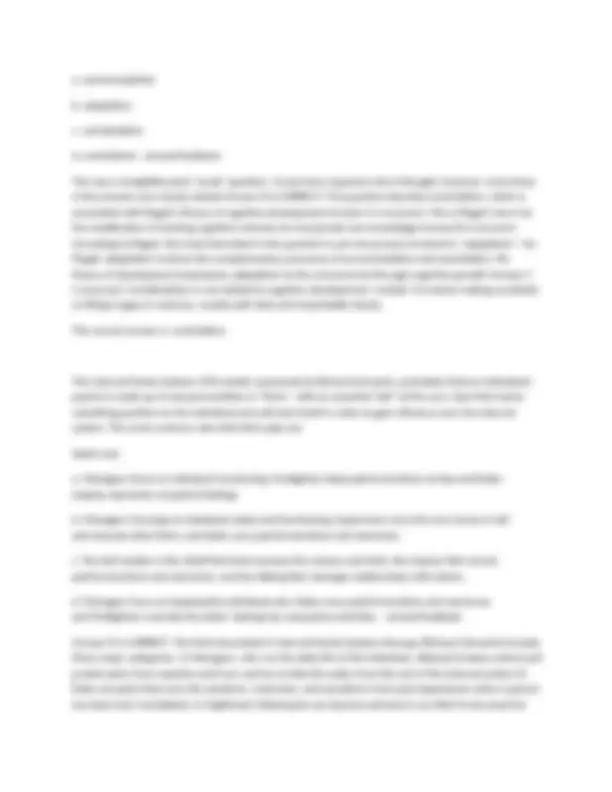
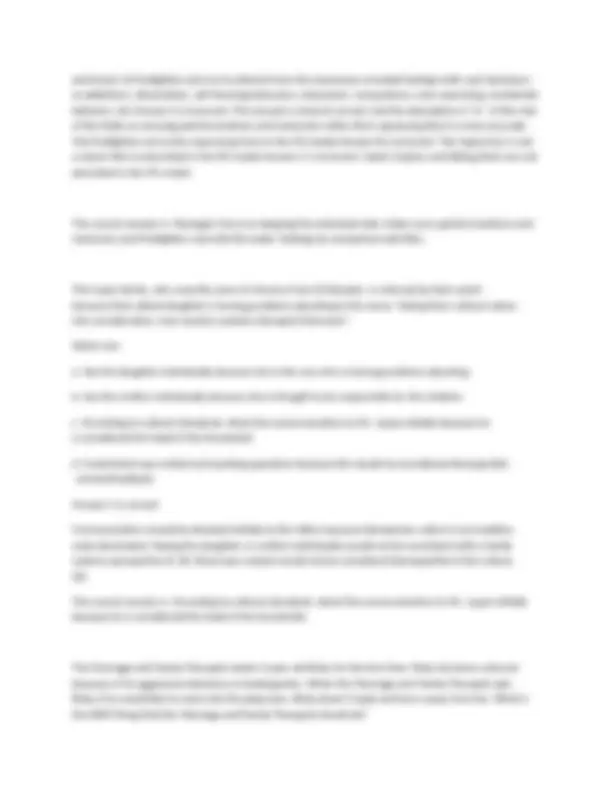
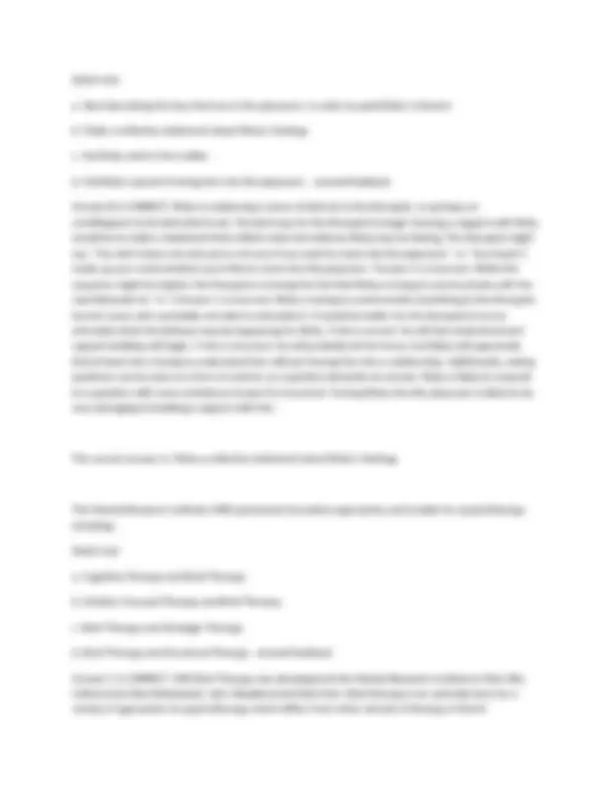
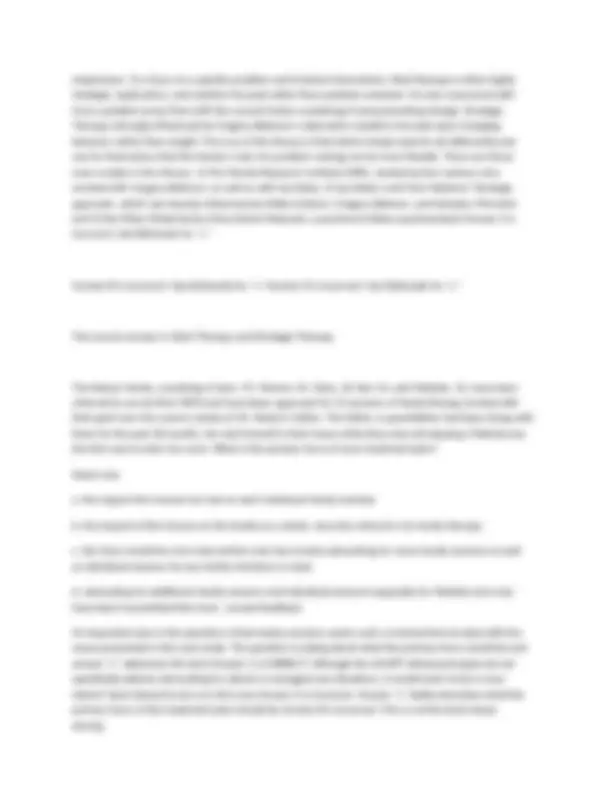
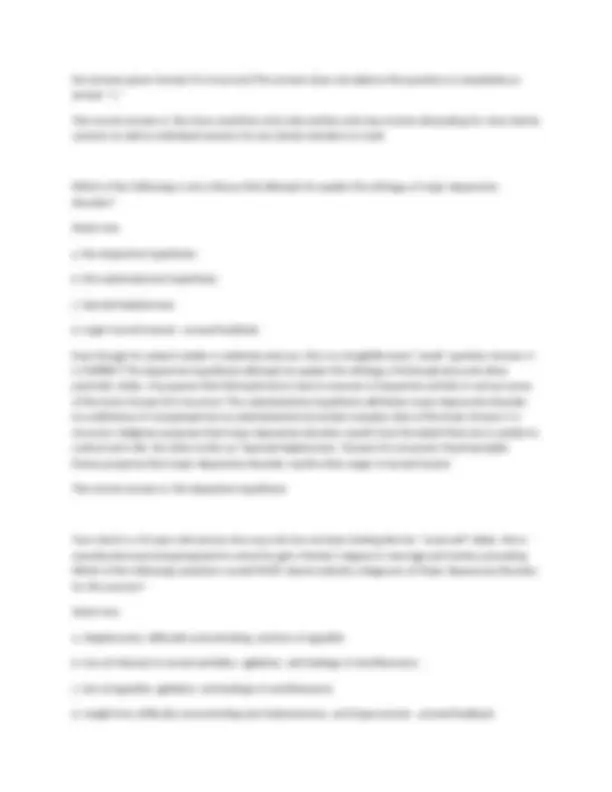



Study with the several resources on Docsity

Earn points by helping other students or get them with a premium plan


Prepare for your exams
Study with the several resources on Docsity

Earn points to download
Earn points by helping other students or get them with a premium plan
Community
Ask the community for help and clear up your study doubts
Discover the best universities in your country according to Docsity users
Free resources
Download our free guides on studying techniques, anxiety management strategies, and thesis advice from Docsity tutors
A set of multiple-choice questions related to marriage and family therapy (mft) practice. Each question focuses on a specific clinical scenario or concept, requiring the user to select the most appropriate answer from a list of options. Detailed rationales for each answer, explaining why the correct choice is the best and why the other options are incorrect. This format is valuable for students preparing for mft exams or professionals seeking to enhance their knowledge and understanding of mft principles and practices.
Typology: Exams
1 / 62

This page cannot be seen from the preview
Don't miss anything!























































A young woman comes to therapy alone. She has been dating a man for almost a year and they recently began having sexual relations. Although the woman is sexually aroused during intercourse, she is unable to achieve orgasm through either intercourse or clitoral stimulation. The woman says that, while this is her first experience with intercourse, she has masturbated to orgasm several times. In treating the woman a therapist using Masters and Johnson's approach to sex therapy is most likely to recommend that the woman use which of the following techniques? Select one: a. The bridge technique b. The stop-start technique c. Sensate focus d. The squeeze technique - answerAlthough many questions that ask you to choose an intervention are "best answer" questions, this is a "one-correct-answer" question because Masters and Johnson suggest specific procedures for treating each sexual dysfunction.Answer C is correct: In treating secondary Orgasmic Disorder, Masters and Johnson emphasize the sexual value system and recommend giving the couple permission to be sexual, using sensate focus with constant communication of likes and dislikes to the partner, genital play, penile containment without thrusting, and, finally, coitus.Answer A is incorrect: Be careful: this is associated with Kaplan's treatment for secondary Orgasmic Disorder.Answer B is incorrect: This is associated with Kaplan's treatment for Premature Ejaculation.Answer D is incorrect: This technique is associated with Masters and Johnson, but is used to treat male sexual dysfunction, such as Premature Ejaculation. The correct answer is: Sensate focus Based on the initial evaluation of a 15-year-old boy, a clinician believes the nature and number of his symptoms suggest a DSM-5 diagnosis of Attention-Deficit or Hyperactivity Disorder, predominantly inattentive presentation. Before assigning the diagnosis, the clinician will want to confirm that some symptoms were present before the boy wasyears of age and that he exhibits them in at least settings. Select one: a. 7; 2 b. 12; 2
c. 6; 3 d. 10; 3 - answerAnswer B is correct: For a diagnosis of ADHD, the DSM-5 requires that "several inattentive or hyperactive-impulsive symptoms were present prior to age 12" (p. 60) and that symptoms are present in at least two settings. Answer A is incorrect: This answer describes the DSM-IV-TR requirements for the diagnosis. The correct answer is: 12; 2 Bipolar I Disorder is distinguished from Bipolar II Disorder by the presence of which kind of episode? Select one: a. Manic episode b. Psychotic episode c. Mixed episode d. Depressed episode - answerThis is another straightforward recall question about diagnosis.Answer A is correct: The presence of a manic episode rules out Bipolar II Disorder. The criteria for diagnosing Bipolar I Disorder include one or more manic episodes.Answer B is incorrect: With psychotic features is a specifier for Bipolar I Disorder, but psychotic episodes are not one of the types of episodes associated with the Bipolar Disorders. The correct answer is: Manic episode Charles and Martha bring their two children to therapy. The parents are concerned with how disrespectful the youngest child is to the mother. Whenever she tries to discipline him, he engages in name-calling and has threatened violence. The therapist asks the mother to recall a recent event that occurred and notes that the husband rolls his eyes and looks away as she begins to speak. When the therapist calls attention to the husband's response, the youngest child immediately lashes out at his mother. A structural therapist would view this interaction as: Select one: a. Conflict-detouring. b. Reciprocal inhibition. c. Equifinality.
Clementine, an 18-year-old high school senior, is referred for therapy by her physician. She went to see her doctor due to constipation and menstrual irregularity. Though slightly underweight, Clementine talks excessively about being fat and unattractive. When prompted by the MFT, she admits to thinking that food is a "tyrant" in her life. She also discloses that she sometimes "gorges on food" to a point where she feels sick and throws up, but is quick to add that she does this no more than a couple of times a week. Based on this information, the most likely diagnosis for Clementine is: Select one: a. Anorexia Nervosa, binge eating or purging type. b. Bulimia Nervosa. c. Major Depressive Disorder with atypical features. d. Body Dysmorphic Disorder. - answerThe information presented in this question suggests that Clementine has an eating disorder.Answer A is incorrect: Anorexia and Bulimia share some features (e.g., disturbed body image), but a person with Anorexia refuses to maintain weight over a minimal normal level for her height and age.Answer B is correct: The primary clue indicating that Clementine has Bulimia, rather than Anorexia, is that she is only slightly underweight. Other signs of Bulimia include her lack of control over eating ("food is a tyrant"); her preoccupation with her body shape and weight; and her gorging on food and vomiting. Finally, menstrual irregularity (and even amenorrhea) occurs in some females with Bulimia and constipation can develop in individuals who chronically abuse laxatives.Answer C is incorrect: Major Depressive Disorder with atypical features often includes overeating, but Clementine is not exhibiting other symptoms of depression.Answer D is incorrect: You can rule this out since Clementine clearly seems to have an eating disorder. The essential feature of Body Dysmorphic Disorder is a preoccupation with an imagined or minor physical flaw. The correct answer is: Bulimia Nervosa. During an initial interview with a patient who was recently admitted to the hospital, a therapist finds that the patient tends to take an unusually long time to answer questions because he spends a lot of time providing minute details and making parenthetical comments. However, the patient doesn't seem to lose track of the point he is trying to make and usually ends up answering the questions. The man's speech pattern is best described by which of the following terms? Select one: a. Loosening of associations b. Circumstantiality c. Confabulation
d. Flight of ideas - answerA key feature of this person's speech is that he does not lose the original point.Answer B is correct: The man's speech pattern illustrates circumstantiality. His speech wanders somewhat but he continues to be aware of the original point.Answer A is incorrect: Loosening of associations involves incoherent, rambling speech and loss of the original point.Answer C is incorrect: Confabulation involves the fabrication of details or events in order to fill in information gaps resulting from memory loss.Answer D is incorrect: Flight of ideas involves a nearly continuous flow of rapid speech with abrupt changes from one topic to another. The correct answer is: Circumstantiality During your first session, a new client tells you that she sometimes gets very light-headed and "shaky" and that, during these periods, she has an impending sense of doom and feels like she's going to die. She says these feelings "come and go" and don't seem to be related to anything she's doing at the time. A representative from her insurance company calls a few days after this session and requests a diagnosis. He says the company will not reimburse for the session unless it receives a diagnosis with the first billing. You generally do not like to assign a diagnosis without doing a complete assessment, but you want to get paid. Therefore, you hazard an "educated guess" and assign which of the following diagnoses? Select one: a. Panic Disorder b. Generalized Anxiety Disorder c. Schizoid Personality Disorder d. Schizophreniform Disorder - answerThis vignette does not offer much in terms of symptoms, so you have to do the best you can to arrive at a tentative diagnosis. Many questions on the MFT exam will not list the full criteria for a diagnosis but will, instead, only hint at the probable diagnosis.Answer A is correct: Panic Disorder requires the occurrence of at least two unexpected panic attacks that include physical symptoms (e.g., light headednes) and cognitive symptoms (fear of dying).Answer B is incorrect: Generalized Anxiety Disorder (GAD) is characterized by excessive anxiety and worry about multiple events. It is not associated with an impending sense of doom or fear of dying.Answer C is incorrect: Schizoid Personality Disorder does not involve the symptoms described in the question.Answer D is incorrect: Schizophreniform Disorder does not fit the clinical picture described here. The correct answer is: Panic Disorder During your first session with Mr. and Mrs. Desvelo, Mr. Desvelo says his wife has insisted that he get "some help" with his sleep problems. Mrs. Desvelo states that she's awakened by his frightening screams at least once a week, usually a few hours after they go to sleep, and that this is having a negative effect
a. Body Dysmorphic Disorder b. Somatic Symptom Disorder c. Hypochondriasis d. Illness Anxiety Disorder - answerAnswer D is correct: Illness Anxiety Disorder is characterized by a preoccupation with having a serious illness, an absence of somatic symptoms or the presence of mild somatic symptoms, a high level of anxiety about one's health, and performance of excessive health- related behaviors (care-seeking type) or maladaptive avoidance of doctors, hospitals, etc. (care- avoidant type). Answer A is incorrect: Body Dysmorphic Disorder is characterized by a preoccupation with a defect or flaw in appearance that appears minor or is unobservable to others. Answer B is incorrect: Somatic Symptom Disorder involves the presence of somatic symptoms, while Illness Anxiety Disorder is characterized by the absence of somatic symptoms or the presence of only minimal symptoms. Eliana is worried about her health but does not actually have physical symptoms. Answer C is incorrect: Hypochondriasis is a DSM-IV-TR diagnosis. The correct answer is: Illness Anxiety Disorder Common sense solutions to problems rarely work. What theoretical orientation supports this belief? Select one: a. experiential family therapy b. structural family therapy c. strategic family therapy d. extended family systems - answerTo answer this question correctly, you needed to have some knowledge of each theory presented in the responses.Answer C is CORRECT: Strategic family therapists are united in the belief that "common sense" solutions to problems rarely work. They believe that objectivity has been lost regarding what is perpetuating the problem and, as such, people become increasingly stuck in doing more of the same. Answer A is incorrect: Experiential family therapy focuses on the present and the therapist observes here-and-now data from experiences. This theoretical orientation does not support the statement that common sense solutions don't work.Answer B is incorrect: Structural family therapy focuses on the present and the past, along with the family's current structure carried over from earlier transactional patterns. This theoretical orientation does not support the statement that common sense solutions don't work.Answer D is incorrect: Extended family systems therapy views behavioral disorders as the result of a multigenerational transmission process in which progressively lower levels of differentiation occur as the family's lack of differentiation is transmitted
from one generation to the next. This theoretical orientation does not support the statement that common sense solutions don't work. The correct answer is: strategic family therapy Derrick, a 16-year-old boy, is mandated to counseling by the juvenile court due to stealing and vandalism. He says to you that he does not want to see you, but he has no choice because he has to fulfill his probation requirement. He says, "don't bother to fix me. I just want you to write a letter to tell my P.O. that I am fine. I am happy; you are happy!" As a psychodynamic therapist, which of the following would be a good intervention in the initial stage? Select one: a. Help him explore and understand his resistance. b. Ask him how he feels about not having a choice to come see you. c. Establish a safe holding environment. d. Assess if he sees you as a "bad" object like he sees the probation officer. - answerAnswer B is correct: This is a good initial stage psychodynamic intervention to explore and understand how Derrick feels in order to establish trust and rapport. Derrick is showing resistance to help but it is premature to help him understand his resistance in the initial stage as the therapeutic relationship is still forming (A). Establishing a safe holding environment is an initial stage treatment goal for psychodynamic therapy (C). The ways to achieve this are through clarifying and containing feelings, recognizing client concerns, clarifying therapeutic boundaries and expectations, etc. Considering Derrick's perception of you would be relevant, but it is not an intervention (D). The correct answer is: Ask him how he feels about not having a choice to come see you. Dialectical Behavior Therapy targets behaviors in which order: Select one: a. Decreasing suicidality, decreasing therapy interfering behaviors, increasing quality of life reduction, acquisition of behavioral skills b. Decreasing high-risk behaviors, decreasing therapy interfering behaviors, decreasing quality of life interferences, acquisition of relational skills c. Decreasing high-risk behaviors, acquisition of behavioral skills, decreasing therapy interference, increasing quality of life
present but, as Lenore Walker (1979) has indicated in her research, there is actually an underlying, predictable cycle in domestic violence relationships. So, while the batterer may isolate the victim by controlling what he or she does, who he or she sees and talks to, and where he or she goes, the inclusion of impulsivity in this answer makes it a poor choice.Answer B is incorrect: In this context, isolating could be considered a coercive behavior, which make these two terms synonymous. "C" is a better choice.Answer D is incorrect: Isolation could be a factor that contributes to mutual dependence. However, these characteristics (assuming that the isolation is not due to coercive behavior) can be found in non-violent relationships, as well. The correct answer is: coercive behaviors and mutual dependence Don and Ginny, a couple in their 30's, come to see you with their 6-year-old daughter, Ellen. They tell you that Ellen was frightened by an earthquake two years ago and came into their bed to sleep. Since then, she refuses to sleep in her own bed. Don wants this stopped, but Ginny says she can't stand hearing Ellen scream when she's returned to her own bed. As a behavioral therapist how would you intervene? Select one: a. Have the couple get a lock for their bedroom door. b. Utilize a reward system to get Ellen to sleep in her own bed. c. Refer Don and Ginny to parenting classes. d. Refer Ellen to an M.D. for an evaluation. - answerAnswer B is correct: Utilizing a reward system is the best answer available. In this situation, Ellen needs to have permission to state her fears and realize she can soothe herself. This acknowledgment of her feelings can be coupled with the behavioral approach. One way to reinforce the "staying in her own bed" behavior would be to utilize a reward system. Having the parents lock their bedroom door is likely to increase the child's anxiety (A). Referring the parents to a parenting class might be helpful, but it is not specific to this question looking more for a behavioral intervention (C). A physician referral is never wrong. However, the question is looking for a behavioral intervention (D). The correct answer is: Utilize a reward system to get Ellen to sleep in her own bed. Dorrie is a 68-year-old widow who lives alone in her home of 32 years. Her neighborhood now has an alarmingly high crime rate. Dorrie maintains that she loves her home and wouldn't consider moving. She seems unaware of any danger, although her neighbors often talk about local attacks and robberies. Dorrie has reduced her anxiety by unconsciously blocking her awareness of threatening ideas and impulses that could feed it. She is using a defense mechanism known as:
Select one: a. regression b. repression c. projection d. introjection - answerThis was a "recall" question but it could have been difficult because all four answers are defense mechanisms.Answer B is CORRECT: The woman is "repressing" unwanted thoughts and impulses.Answer A is incorrect: Regression occurs when, in response to threatening thoughts and feelings, an individual returns to an earlier stage of development that was more pleasurable, secure, and free from anxiety.Answer C is incorrect: Projection involves attributing undesirable impulses to the external world.Answer D is incorrect: Introjection is the opposite of projection and involves ascribing others? thoughts and behaviors to oneself in order to better control one's affective response to the thoughts and behaviors. The correct answer is: repression During a divorce, the children are least likely to: Select one: a. try to find a "replacement" for the absent parent b. idealize the non-custodial parent c. blame themselves for causing the divorce d. feel anger toward the custodial parent - answerBy reducing this item to the "question's question," you can see that it is asking for the least likely effect of divorce on children.Answer A is CORRECT: It is not common for children to look for someone to replace the absent parent. Rather, they often idealize the absent parent (i.e., the one who sees them for visitation but doesn't live with them).Answer B is incorrect: It is common for children to idealize the absent parent.Answer C is incorrect: It is common for children, especially younger children, to blame themselves for their parents' divorce.Answer D is incorrect: It is common for children of divorce to take out their anger on the parent who lives with them (i.e., the custodial parent). The correct answer is: try to find a "replacement" for the absent parent During a therapy session, the husband says, "I think A-B, A-B." His wife responds, "No, it's B-A, B-A." In this situation, Don Jackson would most likely recommend that the therapist respond by:
Father-daughter incest may produce either sexual promiscuity or sexual inhibition in the daughter during adulthood. This illustrates which of the following? Select one: a. equifinality b. wholeness c. equipotentiality d. non-summativity - answerThe question illustrated a clear example of equipotentiality, which is a general systems theory concept proposing that one cause (e.g., incest) may produce different results (e.g., promiscuity or sexual inhibition).Answer C is CORRECT: This is correct; see above.Answer A is incorrect: The general systems theory concept of "equifinality" proposes that no matter where one enters a system, the patterning will be the same. According to this concept, different causes can produce the same results and, thus, a therapist should study patterns of behavior and interaction in a client family rather than individual topics.Answer B is incorrect: The general systems theory concept of "wholeness" proposes that every part of a system is so related to its fellow parts that a change in one part of the system inevitably causes a change in the other parts and in the whole system.Answer D is incorrect: Non-summativity means "the whole is equal to more than the sum of its parts"; thus, the family has a history and function of its own beyond the identities of its members and is a treatable entity, not just a collection of individuals. The correct answer is: equipotentiality For an American Indian client with depressive symptoms, treatment is most likely to be effective if: Select one: a. the therapist is familiar with traditional tribal medicine and spiritual practices b. the therapist works from a humanistic-existential perspective c. the therapy is primarily cognitive behavioral d. the whole family is in treatment - answerChoosing the best answer requires you to have some knowledge of American Indian culture.Answer B is CORRECT: It would be best to choose the psychotherapy approach that would be most consistent with American Indian tradition. Most traditional tribal spiritual practices involve telling stories, experiencing intense emotions, guided imagery, and/or meditation. These are most consistent with humanistic/existential therapy. This orientation is also present-oriented, which is another reason it is a good choice.Answer A is incorrect: This answer choice might have tempted you, but the majority of American Indians are not actively involved in traditional
healing practices, so understanding these practices may not help you in planning effective treatment.Answer C is incorrect: The research suggests that this would not be a good answer choice because this orientation is too directive.Answer D is incorrect: This is also a good choice, because American Indian families tend to be close and connected, but traditional spiritual and healing practices are usually individual solitary quest experiences, which might suggest family sessions would be less effective. The correct answer is: the therapist works from a humanistic-existential perspective For an ego analyst, the primary intervention strategy is to help the client: Select one: a. gain insight into how his or her past continues to influence the present b. become more fully and completely the person he or she is capable of becoming c. replace irrational thoughts, ideas, and verbalizations with rational, healthy ones d. reintegrate into conscious awareness the disowned parts of the self - answerIf you didn't know that answer "a" describes ego analysis, you might have figured this out by using a process of elimination (assuming that you recognized the therapies described in answer "b," "c, " and "d"). The ego analysts (e.g., Anna Freud, Erikson) stress the role of the ego in personality development and propose that the ego is involved in a wide variety of psychological functions. They believe that healthy behavior is under the conscious control of the ego and that pathology results when the ego loses its autonomy from the id or from reality and behavior is no longer under the individual's conscious control (Wolberg, 1988).Answer A is CORRECT: Although ego analysts tend to emphasize current problems over past experience, an important goal of therapy is to help clients identify what things in the present can be altered to correct the harmful effects of the past.Answer B is incorrect: This describes client-centered therapy and other humanistic therapies.Answer C is incorrect This describes rational emotive therapy.Answer D is incorrect This describes gestalt therapy. The correct answer is: gain insight into how his or her past continues to influence the present For Minuchin, scapegoating and overprotection of a child by the child's mother and father are both forms of: Select one: a. triangulation. b. detouring.
c. The client has concluded they no longer need therapy. d. The client has gained insight into the root causes of his/her problems. - answerAnswer C is correct: The client is considered to be the expert in his/her own life and therefore is in control of the therapy. If the client decides s/he is done, then therapy is complete. The reduction of emotional reactivity would be a goal of, and possible termination criterion for multigenerational (Bowenian) therapy (A). The therapist is not considered the expert in solution-focused therapy and therefore would not conclude that the client is ready to terminate; that decision would come from the client (B). Gaining insight into problems is a more psychodynamically-oriented termination criterion. In fact, a solution-focused therapist would not consider a client to have problems as much as s/he would focus on strengths and pay attention to what is working in the client's life (D). The correct answer is: The client has concluded they no longer need therapy. You are a cognitive-behavioral therapist who has been treating Gail, a woman in her late-forties who has raised three children. Her husband urged her to return to work part-time and you have been helping her with her anxiety and self-esteem issues about returning to work. She has now been working for 6 weeks in a new job she likes, and you begin the termination process. During the last termination session, Gail says she still worries sometimes, "I'll mess up and I won't be able to handle the responsibility." Your BEST intervention would be to: Select one: a. Normalize her fear of messing up. b. Tell Gail that you also have had periods in your life when your irrational beliefs got the better of you. c. Explore Gail's regression and ask clarification and amplification questions. d. Acknowledge her irrational belief, remind her of an alternative belief she has created and encourage her to continue to remind herself of these alternative beliefs in the future. - answerAnswer D is correct: These are all appropriate interventions for a client in the last stage of cognitive-behavioral therapy who is expressing self-doubt based on previously held irrational beliefs in the last session(s). Cognitive- behavioral therapists would not normalize a distorted thought or irrational belief; they would instead challenge it (A). Answer choice B is self-disclosure that would be unlikely to be made by a cognitive behavioral therapist. Identifying regression and providing clarification are techniques from Psychodynamic therapy rather than Cognitive-behavioral approaches; in addition, this is her last session, and these types of interventions presume ongoing therapy (C). The correct answer is: Acknowledge her irrational belief, remind her of an alternative belief she has created and encourage her to continue to remind herself of these alternative beliefs in the future.
You are a psychodynamic therapist successfully ending long-term therapy with a client. Which of the following is most likely to be going on? Select one: a. An increase in transferential phenomena. b. The client is expressing feelings of sadness at the ending of the therapy. c. The original symptoms will recur. d. Previously unexpressed hostility will surface. the ending of the therapy. - answerThe key word in this question is that therapy was successful.Answer B is CORRECT: Successful therapy often results in a real attachment and the client will be very appropriately processing sadness as the relationship ends.Answer A is incorrect: Successful psychodynamic therapy includes the working through of transferential material.Answer C is incorrect: The return of the original symptoms are unlikely to recur, since presumably the successful therapy has brought the unconscious conflicts underlying those symptoms to awareness.Answer D is incorrect: Hostility is more likely near the beginning of therapy as an expression of resistance. The correct answer is: The client is expressing feelings of sadness at You are referred a new client with a number of unusual symptoms. You call a colleague and share with him the highlights of the case, being careful to disguise the identity of your client. Why would you confer with another mental health professional about a current client? Select one: a. to make a comprehensive treatment plan b. to determine whether the case is within your scope of practice c. to decide whether you should bill the client at the high end of your sliding scale d. to develop good will and referral potential with this colleague - answerAlthough it described a specific case, this question simply asked for the main purpose of consultation.Answer A is CORRECT: This is not a great answer, but is the best of the four given here. Marital and family therapists confer with colleagues about clients to gain information, check their assessment, and develop a treatment plan.Answer B is incorrect: A marital and family therapist should know whether a case is within his/her scope of practice without having to seek consultation from a peer.Answer C is incorrect: A sliding scale is predetermined and should not be changed on the basis of advice from another professional. A therapist may, however, want to periodically check with his/her peers to see what they are charging in order to remain
After 8 months of therapy, it is safe to assume that you would have already done the things suggested in the other choices, such as talking to colleagues regarding the case, reading relevant literature to help you with this case, and dealing with your client's resistance in therapy. At this point, it is in the client's best interest to be referred to another therapist, while also processing termination with him. The correct answer is: Raise the possibility of termination and give referrals to another therapist. You have been treating a single father of four children for the last six months and have been planning for termination. He comes into session very distraught and tells you that his mortgage cannot be refinanced, and the bank is starting foreclosure proceedings on his home. How BEST would you proceed? Select one: a. Renegotiate the treatment contract. b. Continue with termination as planned. c. Refer to Consumer Credit Counseling. d. Postpone termination for an additional month. t. - answerAnswer A is correct: Renegotiating the treatment contract changes the treatment process from termination to addressing the new psychosocial stressor. An even better response would have been to ask the client if he wanted to continue treatment or not. Continuing with termination ignores the client's new and very significant psychosocial stressor (B). Referring to Consumer Credit Counseling does not address the client's emotional reactions (C). Postponing termination for an additional month does not address the need to renegotiate the terms of the treatment contract, as it only focuses on a time frame of treatment (D). The correct answer is: Renegotiate the treatment contrac The Randazzos have been in couples counseling for 6 months. In session, it appears the couple has made tremendous progress, improving both their communication skills and their level of intimacy. During the last session, however, the couple announced that they have decided to file for divorce. The decision comes as a shock to the therapist who was convinced that this couple was committed to their marriage. The therapist expresses concern that the couple's decision may be hasty and suggests they take time to determine whether this is the best decision considering all the progress they have made. The therapist should: Select one: a.Consult with a colleague.
b.Explain the nature of couples therapy and how sometimes things get worse before they get better. c.Determine how goals should be adjusted considering this new information. d.Review the progress they have made and explore how they came to this decision. - answerAnswer A is correct: The therapist would benefit from a consultation with a colleague to explore possible countertransference issues that may be impacting the therapeutic relationship. The way the vignette is worded indicates the therapist's own agenda may be coming into play. The fact that the therapist is "shocked" and was "convinced that this couple was committed to their marriage," along with his suggestion that the couple's decision is "hasty," indicate that this therapist may have a strong desire or need for this couple to stay together. Relationships often change as a result of couples counseling, and sometimes the change means that the relationship no longer serves either party. The correct answer is:Consult with a colleague. Under HIPAA's Privacy Rule, a health care provider may disclose protected health information (PHI) without a patient's authorization: Select one: a. only when the disclosure meets the "minimum necessary" standard. b. only when the information is needed to provide the patient with emergency services. c. when the information will be used for routine treatment, payment, and health care operations. d. whenever the provider has determined that it is in the patient's best interests to do so. - answerNote that this question is asking about HIPAA's Privacy Rule and not about other legal or ethical requirements.Answer C is correct: Of the answers given, this one is most consistent with the Privacy Rule, which states that a written authorization from the patient is required before a provider discloses PHI except when the information is being disclosed for routine purposes related to treatment, payment, or health care operations ("TPO") or in other legally defined situations (e.g., when disclosure is necessary to avert a serious threat to the health or safety of the patient or other person). The correct answer is: when the information will be used for routine treatment, payment, and health care operations. What are the restrictions, according to AAMFT, upon a therapist acting as a custody evaluator? They may perform a custody evaluation if: Select one: a. They receive informed consent from the client about the risks and benefits.